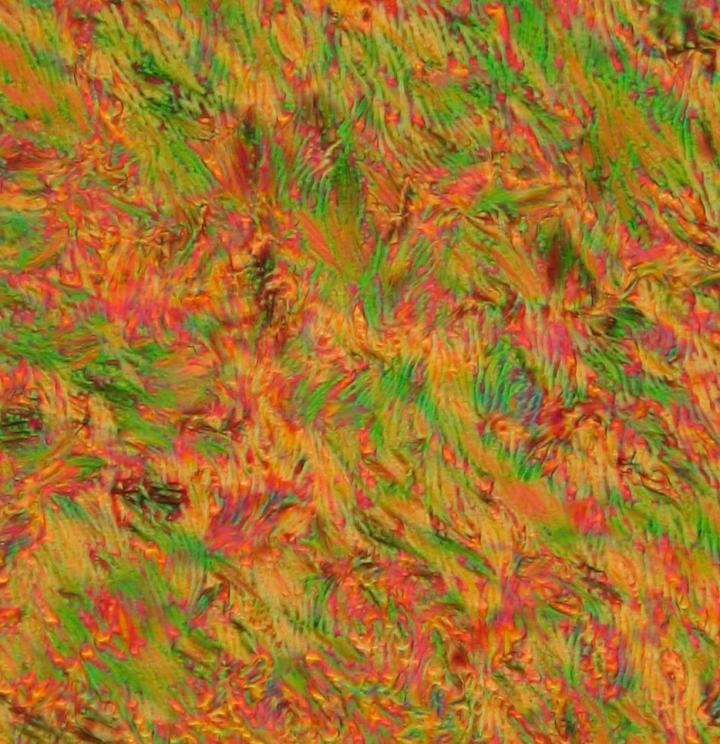Aug 21 2017
New liquid-crystal photochromic polymers have been synthesized and studied by members of the Faculties of Chemistry and Fundamental Physical and Chemical Engineering at the Lomonosov Moscow State University in association with foreign partners.
 This is an LCD texture observed in a polarization-optical microscope. (CREDIT Alexey Bobrovsky)
This is an LCD texture observed in a polarization-optical microscope. (CREDIT Alexey Bobrovsky)
The Lomonosov Moscow State University Scientists teamed up with Czech colleagues from the Institute of Physics (Prague) to synthesize and study new liquid-crystal polymers, combing optical properties of liquid crystals with mechanical properties of polymers. Such polymers are capable of quickly changing molecular orientation under the influence of external fields and form coatings, details of complex shape and films.
When compared with low-molecular-mass liquid crystals, an advantage of such systems refers to the fact that at room temperature liquid-crystal polymers are present in the glass-like state, fixing molecular orientation.
Liquid-crystal polymers are made up of molecules with high molecular mass, known as macromolecules. They are comb-shaped pointing out that photosensitive rigid azobenzene fragments (C6H5N=NC6H5) are fixed to the main flexible polymer chain with the help of spacers, comprising of CH2 moieties. These fragments attempt sequencing and are capable of forming a wide range of "packings", such as, liquid-crystal phases. Azobenzene groups isomerize when light strikes such polymers, resulting in modification of the optical properties of the polymers. These polymers are known as photochromic.
The Scientists have specifically concentrated on the processes of photo-orientation and photoisomerization. Photoisomerization refers to the rearrangement of bonds within a polymer molecule under the influence of light. Photo-orientation refers to modification of rod-like azobenzene (in this case) orientation of fragments under the effect of plane polarized light, in whose direction of electric field is firmly determined.
Azobenzene fragments, when exposed to polarized light, change their angle in the course of photoisomerization cycles. This takes place until their orientation becomes perpendicular to the polarization plane of the incident light and also until the fragments are no longer capable of absorbing light.
The photo-orientation process changes the orientation of azobenzene fragments of macromolecules and also brings about emergence of dichroism and birefringence. Dichroism refers to the difference of intensity of polarized light absorption in orthogonal directions. Birefringence is the splitting of light beam into two components with orthogonal (perpendicular) polarization; the direction of one of these components does not change, despite the fact that the second beam is refracted.
The key idea of our project is to study how the chemical structure of new comb-shaped liquid-crystal photochromic polymers influences their phase behavior and photooptical properties. Photoisomerization and photo-orientation processes allow exactly control phase behavior and optical properties of the elaborated systems.
Alexey Bobrovsky, RAS Professor, Doctor of Chemistry, Chief Research Fellow at the Department of High Molecular Compounds of the Faculty of Chemistry, Lomonosov Moscow State University
Initially, Scientists from Lomonosov Moscow State University in association with their Czech colleagues from Institute of Physics, the Czech Academy of Sciences synthesized monomers from which the Lomonosov Moscow State University Scientists attained liquid-crystal polymers. The Authors applied methods of polarizing optical microscopy and differential scanning calorimetry to study phase behavior and temperatures of phase transitions of polymers. Detailed structure of phases was studied by using x-ray structural analysis at the Faculty of Fundamental Physical and Chemical Engineering of the Lomonosov Moscow State University.
The Authors’ remarks suggest that the most vital project part referred to studying photochromism and photooptical properties of the obtained polymers. This stage was split into two parts: the first part focused on irradiation of the polymer films by unpolarized UV light, during which photoisomerization (that is, rearrangement of intermolecular communications) occurred. The second part focused on irradiation by polarized light resulting in photo-orientation.
According to Alexey Bobrovsky, the article deals with a major cycle of projects, dedicated to photoinduced processes in photochromic liquid-crystal polymers. This article is research work only, wherein the authors have analyzed the interconnections between the compound properties and the chemical structure.
Photoisomerization and photo-orientation open large perspectives for creation of so called "smart materials". They react to any external stimuli and could be used for information recording, storage and transfer, as well as in optical devices of diverse complexity. These precise polymers will be hardy used in a real-case scenario as they are too expensive and their synthesis is quite complicated. On the other hand, you can predict not in every instance, what systems will find application at what period of time and in what conditions.
Alexey Bobrovsky, RAS Professor, Doctor of Chemistry, Chief Research Fellow at the Department of High Molecular Compounds of the Faculty of Chemistry, Lomonosov Moscow State University